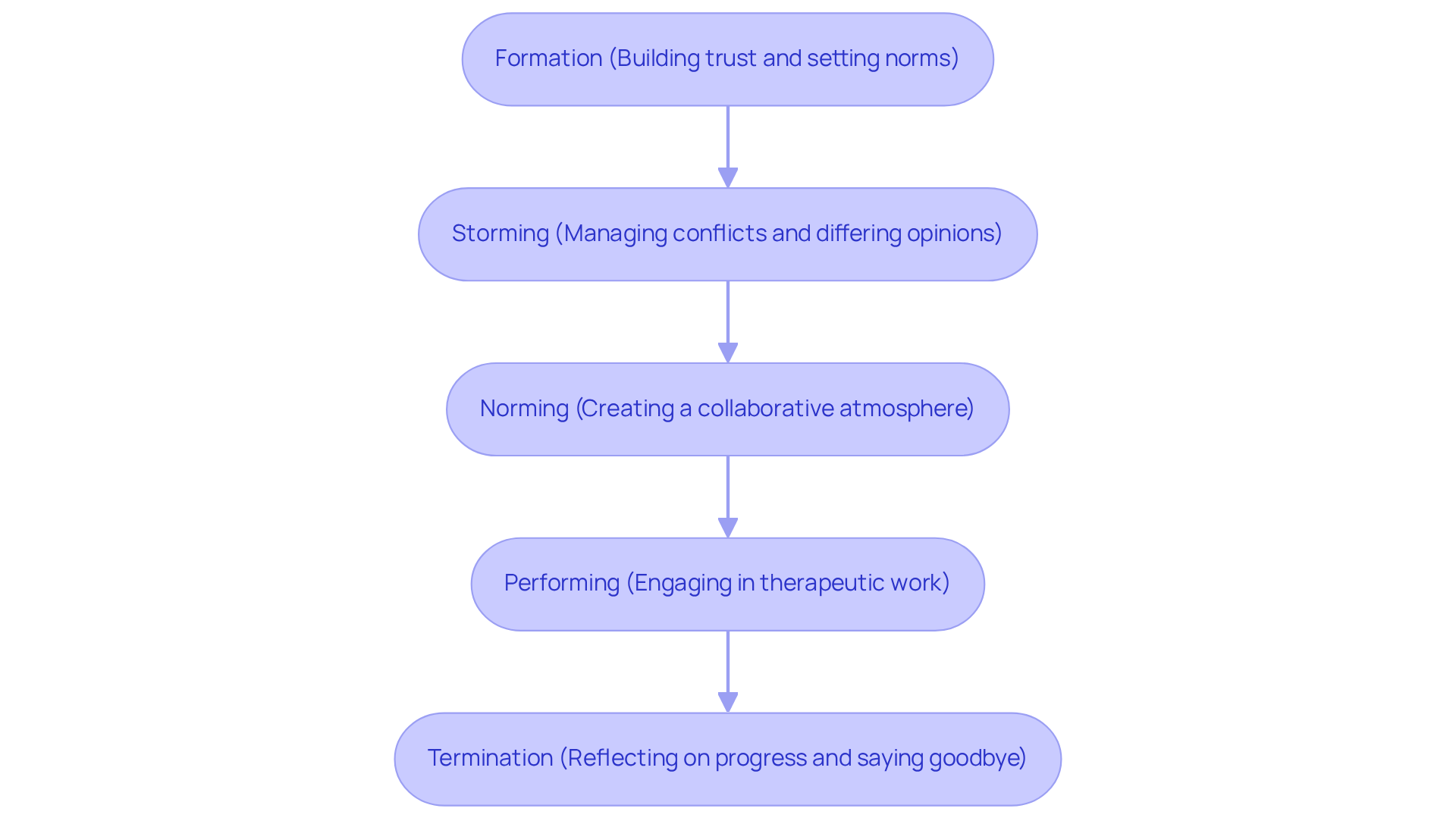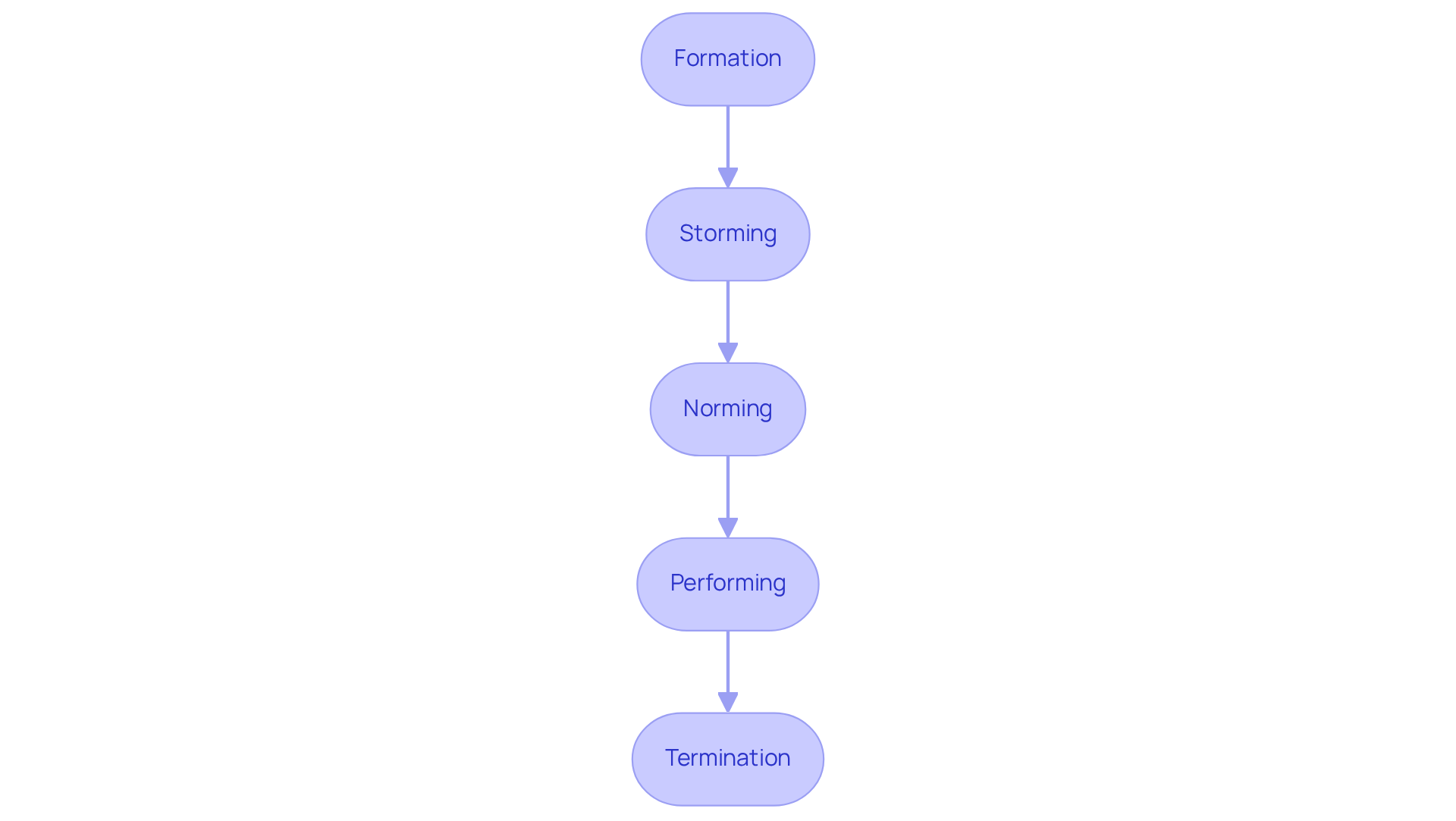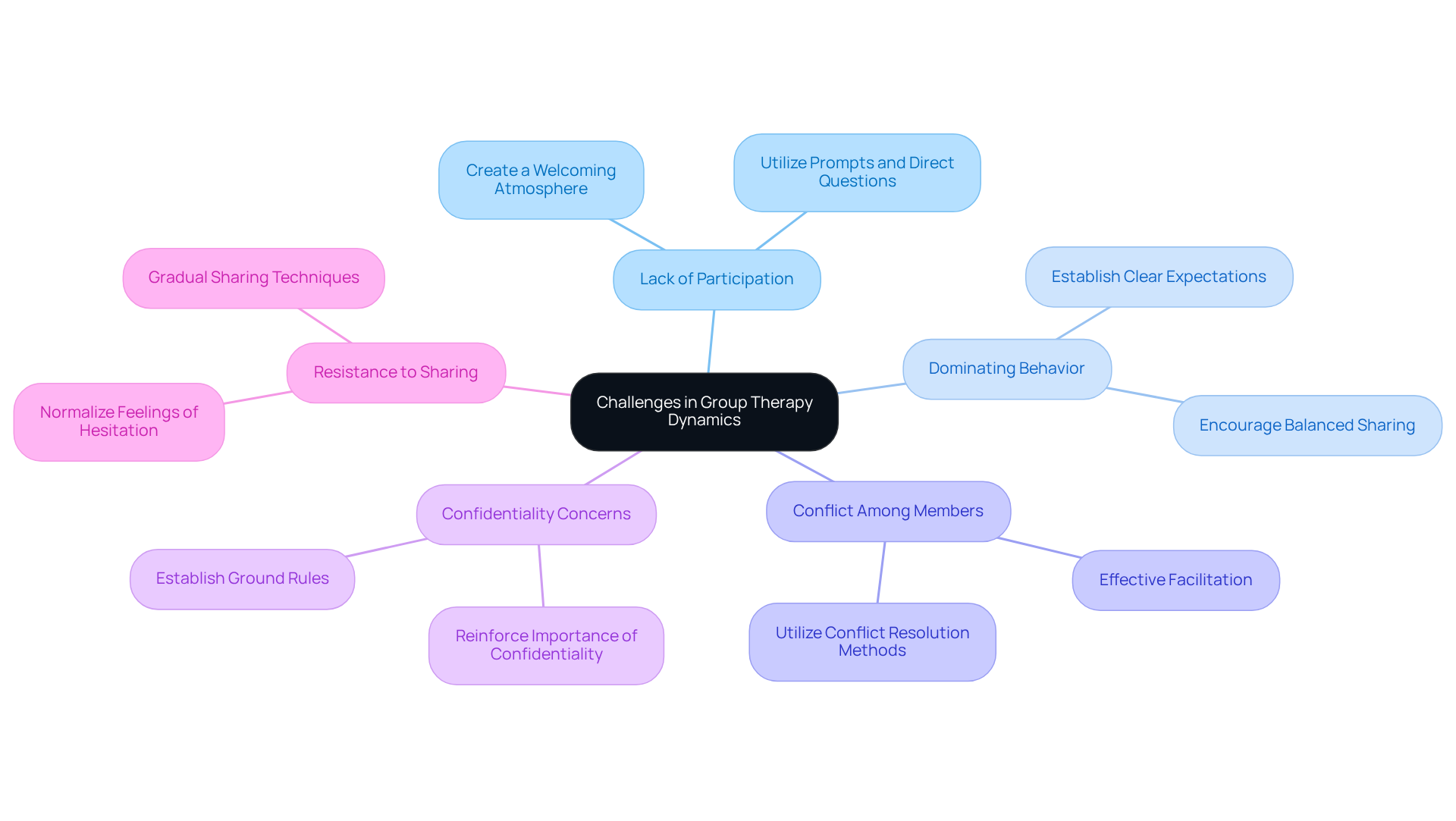Overview
This article explores the stages of group therapy and their vital role in trauma recovery, highlighting how each stage contributes to the healing journey. Have you ever felt overwhelmed by your past? Understanding these stages—formation, storming, norming, performing, and termination—can empower both participants and therapists to cultivate a supportive environment. This nurturing space fosters emotional regulation, resilience, and a sense of community, ultimately enhancing the effectiveness of trauma recovery efforts. Together, we can navigate these stages, embracing the healing process with compassion and understanding.
Introduction
Group therapy stands as a beacon of hope for those navigating the challenging journey of trauma recovery. It nurtures a supportive community where individuals can share their stories and learn from one another. This therapeutic approach not only bolsters emotional resilience but also significantly alleviates feelings of isolation. As participants embark on this collective healing journey, they may find themselves pondering: what are the distinct stages of group therapy, and how do they foster personal growth and recovery? Understanding these phases can unlock the potential for deeper connections and transformative healing experiences. Have you ever felt overwhelmed by your past? Exploring these stages may help you find the support and understanding you seek.
Define Group Therapy and Its Importance in Trauma Recovery
Group counseling is a compassionate form of psychotherapy that involves the stages of group therapy, where individuals come together to share their experiences and emotions, guided by trained therapists. This approach can be especially beneficial for those recovering from trauma, as it fosters a sense of community and belonging among participants. In such a nurturing environment, individuals can openly express their feelings, exchange coping strategies, and gain valuable insights from one another’s experiences, greatly enhancing their healing journey.
Have you ever felt overwhelmed by your past? Research indicates that collective counseling can lead to significant improvements in PTSD symptoms, with mean scores decreasing from 42.5 to 31.2 following treatment. This shared support not only eases feelings of isolation and stigma often associated with trauma but also empowers participants to cultivate emotional regulation skills and resilience.
For instance, a preliminary study involving 32 participants with PTSD revealed that 50% experienced a significant treatment response after completing 8-10 collective counseling sessions. Such findings underscore the essential role of the stages of group therapy as a powerful element in trauma recovery, creating a safe space for individuals to connect and heal together.
Dr. Rachel Kirkman, who leads these sessions, highlights the importance of integrating mindfulness practices to enhance emotional regulation and self-awareness. This allows individuals to observe their thoughts and feelings without judgment, paving the way for deeper healing. As we explore this further, consider how group counseling might be a supportive step on your journey toward recovery.

Explore the Stages of Group Therapy: From Formation to Termination
Group therapy typically unfolds through five distinct stages, each playing a vital role in the healing process:
-
Formation: In this initial stage, participants become familiar with one another, establishing trust and setting norms for the collective. It’s common for individuals to feel anxiety or reservation as they navigate this new environment. This experience is essential for creating a safe space for sharing, where everyone can feel valued and understood.
-
Storming: This phase is characterized by the emergence of conflicts as participants express differing opinions and emotions. It can feel challenging, yet it is a crucial time for fostering team cohesion and addressing interpersonal dynamics. Effective therapists manage these conflicts through active listening and empathy, nurturing an environment where constructive feedback can thrive. Have you ever felt overwhelmed by differing perspectives in a group? This is a natural part of the process.
-
Norming: As the team advances, participants cultivate deeper connections and a feeling of belonging. They begin to share more openly and support one another, creating a collaborative atmosphere that enhances the therapeutic experience. This stage is marked by enhanced collaboration and the formation of a collective identity, where everyone feels they are part of something meaningful.
-
Performing: In this stage, members actively engage in therapeutic work, feeling comfortable sharing their trauma narratives and exploring deeper emotional issues. The therapist promotes communication and fosters reflection on progress, enabling participants to collaborate efficiently towards their therapeutic objectives. It’s a time of growth and healing, where each voice contributes to the collective journey.
-
Termination: The final phase involves reflecting on the progress made, celebrating achievements, and preparing for the end of the group. This stage is vital for assisting participants in returning to their personal lives, armed with the skills and insights acquired during therapy. It frequently evokes feelings like anxiety and sorrow, as participants acknowledge the importance of their collective journey. As you think about concluding your own experiences, what insights have you gained?
Grasping the stages of group therapy is crucial for both therapists and participants, as it enables customized interventions that address the distinct needs of each individual. Ultimately, this understanding improves the therapeutic process. As highlighted by specialists, establishing a secure and encouraging atmosphere is essential for effective collective treatment, allowing individuals to manage their trauma and promote personal development. Remember, the journey of healing is one that you don’t have to face alone.

Implement Effective Techniques for Each Stage of Group Therapy
To maximize the effectiveness of group therapy, specific techniques can be employed at each stage:
-
Formation: Begin this journey with icebreakers and team-building exercises that encourage initial connections among participants. Establishing clear group norms and confidentiality agreements is crucial for creating a safe and trusting environment. At The Emerald Couch, we prioritize collaborative custom treatment planning, ensuring that each individual feels empowered to express what success looks like for them. Have you ever felt the warmth of a supportive community?
-
Storming: During the storming phase of the stages of group therapy, facilitate open discussions about conflicts and encourage members to express their feelings. Implementing conflict resolution strategies can help address tensions constructively, allowing for personal growth and deeper understanding among participants. Building trust and comfort is essential, especially for trauma survivors. Our approach focuses on creating a relationship of trust before delving into potentially triggering topics, inviting members to share their experiences with care.
-
Norming: The norming phase encourages the sharing of personal stories and experiences to deepen connections among members. Activities that promote collaboration and mutual support are essential, as they help solidify the group's cohesiveness and commitment to one another. Mindfulness techniques, such as breath awareness and body scans, can be integrated into this stage to enhance self-awareness and emotional regulation. In what ways have your experiences shaped who you are today?
-
Performing: Performing therapeutic interventions such as cognitive-behavioral techniques, role-playing, and guided imagery is essential in the stages of group therapy. These methods are effective in assisting individuals to process trauma and develop coping strategies, enhancing their overall therapeutic experience. Mindfulness practices can also be employed here, enabling participants to slow down and make intentional choices about their reactions, fostering a deeper understanding of their experiences. Imagine the relief of finding clarity in your thoughts.
-
Termination: Termination in the stages of group therapy involves conducting closure activities that allow members to reflect on their journey, share insights, and express gratitude for the support received. Providing resources for continued support post-therapy is vital for maintaining progress and fostering resilience beyond the group setting. At The Emerald Couch, we ensure that clients are equipped with tools for independent mental health management as they transition to maintenance mode. What steps will you take to carry this journey forward?

Identify and Overcome Challenges in Group Therapy Dynamics
Group therapy can present various challenges that may hinder effective participation. Addressing these issues is crucial for fostering a supportive environment conducive to healing. Have you ever felt hesitant to share in a group? Here are some common challenges and strategies to overcome them:
-
Lack of Participation: To encourage quieter individuals to share, it’s important to create a welcoming atmosphere that invites input. Utilizing prompts and direct questions can help draw out those who may feel hesitant to speak, allowing everyone to feel valued.
-
Dominating Behavior: It’s essential to manage dominating individuals by establishing clear expectations for participation. Encouraging balanced sharing reminds all participants of the importance of equal voice in discussions, fostering a sense of community.
-
Conflict Among Members: Conflicts can arise in group settings, necessitating effective facilitation. Utilizing conflict resolution methods can steer conversations, assisting participants in managing disagreements and promoting mutual understanding, which is vital for healing.
-
Confidentiality Concerns: Reinforcing the significance of confidentiality is vital. Establishing ground rules that emphasize respect and privacy ensures that all members feel secure in sharing their experiences, creating a safe space for openness.
-
Resistance to Sharing: Many participants may feel uncomfortable sharing their thoughts and feelings. Normalizing these feelings can help ease anxiety. Gradual sharing techniques, combined with therapeutic support, can create a safe space for emotional expression.
Statistics suggest that roughly 80% of participants observe enhancements in their interpersonal relationships after six months of collective therapy. This emphasizes the potential for positive results when challenges are effectively managed. Expert insights highlight that creating a supportive environment is key to overcoming participation issues, as it allows individuals to feel seen and heard. Ultimately, this transforms the group into a powerful tool for healing. If you find yourself facing these challenges, remember that seeking support is a courageous step towards your own healing journey.

Conclusion
Group therapy stands as a vital resource for individuals navigating the challenging path of trauma recovery. It creates a supportive environment where shared experiences can foster healing and resilience. Have you ever felt overwhelmed by your past? In this collective process, participants not only confront their own challenges but also find solace in the understanding and empathy of others. This connection ultimately paves the way for personal growth and emotional regulation.
Throughout this article, we have explored key aspects of group therapy, including its significance in healing trauma, the structured stages from formation to termination, and effective techniques for enhancing each phase. The dynamics of group therapy highlight the importance of trust, collaboration, and open communication—essential components for overcoming obstacles and ensuring a successful therapeutic experience. Each stage, from initial introductions to the reflective closure, plays a crucial role in shaping participants' journeys and fostering a sense of community.
The insights shared remind us that while the path to recovery may be fraught with obstacles, the true power of group therapy lies in its ability to transform individual struggles into collective healing. As you consider embarking on this journey, embracing the support of others can be a significant step towards reclaiming your life and building a brighter future. Engaging in group therapy not only enriches personal healing but also reinforces the understanding that no one has to navigate their trauma alone.
Frequently Asked Questions
What is group therapy?
Group therapy is a compassionate form of psychotherapy where individuals come together to share their experiences and emotions, guided by trained therapists.
Why is group therapy important in trauma recovery?
Group therapy fosters a sense of community and belonging, allowing individuals to express their feelings, exchange coping strategies, and gain insights from one another’s experiences, which enhances their healing journey.
How effective is group therapy for PTSD?
Research indicates that collective counseling can lead to significant improvements in PTSD symptoms, with mean scores decreasing from 42.5 to 31.2 following treatment.
What benefits do participants experience from group therapy?
Participants often experience reduced feelings of isolation and stigma associated with trauma, as well as the development of emotional regulation skills and resilience.
Can you provide an example of group therapy effectiveness?
A preliminary study involving 32 participants with PTSD found that 50% experienced a significant treatment response after completing 8-10 collective counseling sessions.
What role does mindfulness play in group therapy?
Mindfulness practices are integrated into group therapy to enhance emotional regulation and self-awareness, allowing individuals to observe their thoughts and feelings without judgment.
Who leads the group therapy sessions mentioned in the article?
Dr. Rachel Kirkman leads the group therapy sessions and emphasizes the importance of mindfulness in the healing process.




